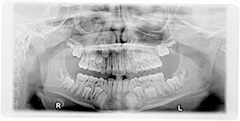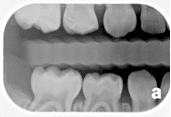Dental Services
X-rays are taken to gain information that a visual exam cannot provide. X-rays are needed to evaluate for cavities between the teeth, show unerupted, extra, or missing teeth, diagnose pathology, evaluate the results of an injury, and plan orthodontic treatment. Using digital x-rays and proper shields means the amount of radiation that is detected is very small (less than flying in an airplane or spending one afternoon outside). Depending on your child’s age, our dentists will prescribe the appropriate radiographs per the American Academy of Pediatric Dentistry guidelines. These x-rays may include a panoramic, periapical, or bitewings films.




A sealant is a coating applied to the chewing surfaces of the back molars. The sealant acts as a barrier to prevent food and bacteria from packing in the grooves of the teeth. Avoiding sticky foods, hard candy, and chewing on ice prevents the sealants and teeth from fracturing. Typically, the dentists only prescribe sealants on permanent teeth
The benefit of fluoride is the topical effect because it inhibits an enzyme in the process of decay. We apply fluoride to prevent sensitivity after the cleaning, to help fight any cavity causing bacteria left in the mouth, and help remineralize any areas that may have the beginning signs of decay. The dentist will prescribe fluoride or fluoride varnish for your child which is applied after the teeth are cleaned. If you have questions about fluoride, our dentists are happy to provide information.
We offer dental treatment services with the most common including composite fillings, stainless steel crowns, anterior resin crowns, pulpotomies, extractions, and enamel microabrasions.
Services that may be used with your child’s treatment in our office include nitrous oxide and local anesthetic. Nitrous oxide and oxygen are administered for dental treatment. The benefit of “laughing gas” is to prevent children from seeing or feeling the local anesthetic and to reduce the vibration felt from the dental handpiece. It also allows us to complete some treatment without using local anesthetic. The child may laugh, feel like they are floating, or have a tingling feeling in their fingers or toes. Nitrous oxide is completely reversible. At the end of the appointment your child will breathe 100% oxygen, which can also have a calming or relaxing effect. There are very few contraindications for using nitrous oxide. Please ask your pediatric dentist if you have concerns.
Local anesthetic or lidocaine is the type of medicine used to “numb” an area in the mouth that will receive treatment. It is used to make the area feel asleep to avoid pain and discomfort while getting a filling, crown, extraction or other surgical procedure. Some dental procedures may not require use of local anesthetic or nitrous oxide.
Following dental treatment your child’s lip, cheek, and/or tongue may be asleep for 2-3 hours. Avoid eating and chewing during this time. It often works well to have your child rest following local anesthetic, so the numbness wears off while they are sleeping. If your child bites the oral tissue, it may look like a yellow strawberry for 3-5 days. It is not an infection. This is tissue regenerating. It takes 10-14 days for healthy tissue to grow. It is important to keep the area clean and is best to avoid salty and acidic foods and beverages. If necessary take Ibuprofen or Tylenol.
Your pediatric dentist may recommend as an option general anesthesia in order to complete your child’s treatment.
When a tooth is removed early because of decay or crowding, our pediatric dentists may recommend a space maintainer to prevent space loss and drifting of adjacent teeth. If your space maintainer is loose, schedule an appointment to have it recemented. This will prevent food from accumulating and causing a cavity. Avoid chewing hard and sticky candy so the space maintainer does not come loose.
